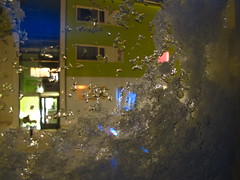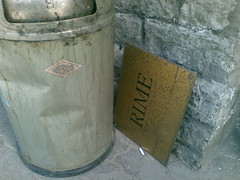Edicy is one of a number of startups funded by Ambient Sound Investments, which in turn is the corporate invocation of the enormous pile of money received by the four Estonians who were in on the ground floor of Skype. I only became aware of it because of a fellow Esto-blogger who got hired to work for them.
What Edicy does, ostensibly, is give you a nice, simple web page editor. It's all done inside the browser, in a cute Web 2.0 sort of way. You know - widgets. Awesome! I thought. It was about time for me to add a page to antyx.net advertising my freelance translation and documentation services, and with Edicy, I could use a very clean and well-color-coded template, just typing in my own text. It even had a rudimentary blog engine, though obviously I didn't need that. I muddled around with the page creator for a bit, but there were bugs in the interface, and I couldn't see what I could do with the page, except leave it there as a numbered placeholder. And, as usual, I was wondering how these folks intended to actually make money off the product.
It is said that history repeats itself thrice: once as a tragedy, again as a comedy, and furthermore for the dumbasses who didn't get the point yet. Time has passed from that early beta stage, and now Edicy is a full-on product. And the product it is, is goddamn Geocities.

Remember Geocities? Cast your mind's eye a decade back, when Al Gore had just invented the Internet, and we were all eager to grab a part of that action. The premier way to leave a mark was to have a Geocities homepage, where you could use a pink swirl image as a repeating background, a MIDI for background music, and post pictures of yourself and your goddamn motherfucking cat.
Geocities was the tragedy. MySpace was the comedy.
(Full disclosure: I might have gotten a Geocities page, but I never really used it. Even back then, I was 1337 enough to code my homepage in Notepad.)
Edicy is Act Three. In their current, presumably finished state, they will let you make a mostly-text page with some nifty browser-based tools. Except you can't do much with it when you're done. What I expected is some sort of export facility, where they would give you an index.html and a folder with all the images and CSS files, with relative paths in the code, so you can simply upload it to wherever you want. Ideally they'd have some sort of generic hosting integration, where you give them your FTP details and they do all the hard work - kind of like I use the Blogger engine to automatically publish static HTML pages to the antyx.net webhost. No setup or knowledge of PHP and chmod required.
Edicy won't let you do any of that. Instead, you have three options. You can publish your page at prefix.edicypages.com - just as the easiest way to use Blogger is to have a prefix.blogspot.com. That's fine for blogs, but personal homepages died out mercifully with the first dotcom crash. The online presence of a regular person these days is on facebook, which doesn't offer an easy-to-remember URL, but does offer a lot of other vastly superior interaction tools (including a perfectly functional search by name, gender and general vicinity). If you have your own website, it will probably be for some kind of business promotion purposes, and at that point you better fucking have your own domain name. It's 2009, you bastard. Godaddy will get you a domain for seven bucks, and webspace is cheaper than toilet paper.
This isn't even Googlepages, which at least has some air of fanboyism about it. I don't approve of Google worship, but at least I understand the mechanism of trying to attach oneself to the aura. But this is Edicypages, and what the fuck is Edicy?
Of course, you don't have to stick to edicypages, just like you don't have to stick to blogspot. Except here's the big difference: Blogger will let you do things with your blog for free. If I wasn't already paying for hosting, I could point the antyx.net domain to Blogger's servers, and none of you would notice a difference, or care. But I have this overarching feeling that the way a blog engine is supposed to work is to generate static HTML that gets published on a webserver that I control, so I do that. It means I can't use some of the newest Blogger widgets, but it's a free service and the important functionality is still there, so I don't especially give a shit.
But Edicy is not like Blogger; it's not one of those Web 2.0, advertising-supported ideas that I loathe so much and criticize for not having a discernible source of revenue. Oh no. Just as Skype charges its users to call regular phones, Edicy will offer its pageholders a premium commercial service.
Enter Edicy Pro. For a small fee, they will host your text-and-images homepage and make it accessable from any domain (that you have to buy separately, of course). They will even let you download the page! And give you priority support!
And the cost? Depending on the length of your commitment, 4-5 Euro per month.
MOTHERFUCKER.
My own web host, the unassailably awesome Tantum.ee, will give you a gig of web space and 25 gigs of traffic per month for eight euro a year. By broadband standards, a gig doesn't seem like a lot, but let me put this into perspective: I only changed up from their cheapest package when the site first got slashdotted and I ran into the traffic cap, which back then was something like 3gb per month. And yes, their hosting package does include a site builder.
Also, I checked: the output of the Edicy page builder is clean HTML. You might need to grab their CSS files as well, but otherwise, open your prefix.edicypages.com page, View Source and save to Notepad.
I mean no offense to Sehr, and I certainly appreciate that they have thought about revenue sources, but OMFG, this is preposterous. Makes me wonder about the whole ASI incubator: the other startup of theirs that I am aware of is a self-customizing RSS feed.









